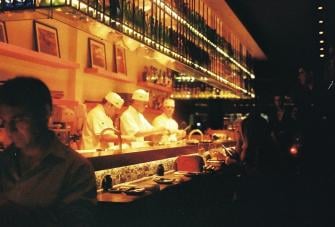How Much Do Restaurants Make in a Day? (Estimates Revealed)
Most business owners want to know how they perform compared with their competition. The restaurant industry is no different.
How much do restaurants make in a day, a week, or a month? When is the best time of the year for restaurants, and how does this change with different kinds of establishments? There are many questions, and whether you're a restaurant owner or a prospective restauranteur, you'll want to research and know where you stand.
So what kinds of restaurant profit margins can you look to maintain, and what's the average restaurant revenue? Read on to find out.
Average profits from a full-service restaurant to a fast food restaurant
The difficult thing about quantifying average restaurant profits is that there are many ways to break down each statistic. So the value of the figures you look at will vary based on how relevant it is to you.
For instance, UK restaurants average between £100,000 and £250,000 in total takings each year. That would mean the average restaurant makes between £500 to £750[1]. Restaurant profit margins (gross profit) can vary from 0-15%, although the average is between 3-5%[2]. This makes creating precise expectations for what a restaurant ought to be taking very difficult.
The 3-5% gross profit target perhaps makes a reasonable and achievable figure for restaurant owners to target, as this remains true no matter what other factors change.
Nevertheless, the factors affecting average profits, takings, and other performance indicators are worth considering.
Factors that can affect how much restaurants make in a day
The factors influencing restaurant business success can be grouped in several ways. These could be those affecting how many covers you can cater, those that influence profit margins, and those that impact the restaurant industry as a whole:
- Restaurant type. Quick-service restaurants tend to profit well, while popular concepts can serve more customers, and some themed restaurants have lower food costs than others.
- Rural or urban location. A rural restaurant business does not have access to as large a customer base as urban competition. Though city-dwellers will travel into the country for a quality meal, remote locations take many restaurants out of the equation for many customers.
- Nearby competition. If two similar restaurants compete for the same local customers, neither will be able to maximize profits. This is particularly common in fast-food and takeaway businesses, where several compete on the same block.
- Time of year, month, and week.
Which kinds of restaurant businesses make more money
Suppose you want to find out which kind of caterers will bring in better profits. In that case, you may be surprised that many of the best profit-making restaurants are not necessarily fine dining or full-service restaurants.
The most profitable restaurant types sell many products with the highest markup. Given that alcohol and wet sales tend to have the best profit margin, this makes bars some of the most profitable restaurants around. Making an average profit margin of 400-500% per wet sale will contribute massively to the bar's success, but with quick service food operating alongside and events to bring in the crowd, the overall average yearly profit of a bar is £30,000[3].
Other restaurants that succeed more often include diners, food trucks, pizzerias and pasta restaurants, vegetarian restaurants, and delivery-only businesses[4]. In this list, there tends to be one of two elements that help drive profits for many restaurants like these.
The first is the low cost of ingredients: pasta, pizza dough, quick service restaurant foods on food trucks, home-delivery, and diner foods tend to be fairly cheap. This helps increase the profit margins of the establishments without damaging the number of covers they cater to.
The second is, though many other businesses have the same concept, they run a popular service that makes it easy to retain customers and acquire new ones. Few people will turn down trying a new pizza restaurant, while vegetarian restaurants have cornered a growing market. While a fine dining establishment will have a high markup, it will not be able to boast either of these traits, with expensive ingredients and an exclusivity that reduces its profit potential.
With a dedicated POS solution for restaurants, Epos Now technology has the perfect hardware and software options to suit your needs:
- Choose from mobile and fixed terminals, build a site-wide printer network, and benefit from a co-ordinated hardware system
- Select your favoured apps from the hundreds available to create a bespoke set-up for marketing, accounting, booking, management and much, much more
- Control your business with ease using simple staff management, speedy inventory control, streamlined pricing structures on flexible software

How to calculate your average restaurant profit margin
So, now you know what figures you can expect to make if you're running an established restaurant. But you'll also need to understand how to calculate your own profits, which isn't as easy as it sounds.
First of all, you'll need a sophisticated enough POS system that generates enough detail in your business reports. The Epos Now restaurant POS can calculate the basic profit margins from your daily sales. If you input the cost price of your products, it will inform you of the net profit you make from each product, which also tells you which of your menu offerings have high-profit margins and are worth upselling as much as possible.
The Epos Now end-of-day process also helps you calculate how much profit you make in a day. However, before that figure can help you figure out your average net profit, you need to incorporate labor costs and other operating expenses.
Understanding your expenses impact on profits
Restaurant owners often focus on profit margin calculation purely through the cost of ingredients and their sales. However, full-service restaurants, in particular, can benefit from lower overhead costs, which require much attention.
Overhead costs include labor, utilities, rent, and marketing expenses. It's important to consider total expenses and reconcile them with your sales revenue to calculate how well your business performs.
Measuring expenses is much easier to do over a month. Many utility companies bill monthly, and you likely pay your staff and rent monthly. Dividing your monthly expenses by the days in the month may be the easiest way to calculate daily expenses.
You can do this by pooling your monthly expenses on a document or using reputable accounting programs like Sage, Xero, or Quickbooks. Accounting programs can help calculate profits by removing all expenses from your restaurant's revenue to leave you a total profit figure.
POS integrations (which Epos Now have with all three programs listed above) can automate this process, and leave you with average revenue figures, split into average monthly revenue or daily revenue, with expenses removed to show profit figures, including tax. These kinds of business insights are something most restaurants dearly need, but many new restaurant businesses struggle to calculate them and lose out as a result.
How to maximize restaurant profits
By now, you're probably wracking your brain trying to think of ways to increase how much revenue you can make, and it can be good to tweak things in your restaurant to see what works and what doesn't.
Subtle changes to menu pricing, bringing in new alcoholic drinks, becoming more of a full-service restaurant, or reverting to quick-service restaurant strategies can all help increase the profitability of the business. Here are a few tips to think about when looking to boost profitability.
Widen the number of revenue streams in the business
One thing most entrepreneurs will tell you is that having multiple streams of income is one of the best ways to raise money. For your restaurant, this likely means offering takeaway and delivery as well as in-house meals. It might also mean running events that can widen your customer base and become a secondary income source.
Given that midweek days tend to be quieter evenings for many restaurants, offering takeaway and delivery (which remain steady throughout the week) can ensure that you'll always be busy with one of your sales channels.
It's important to run an omnichannel business in such a way that none of your channels diminish the success and customer experience of any other channel. For instance, a quiet dining room will become far less appealing if a nearby space is being used for a pop music performance. However, adapting your space to smoothly run in-house meals and events alongside each other can be very marketable and very effective sales strategy.
Focus on improving sales of the high-profit items
Each sale of your product with the highest profit margin is worth a lot more to the business than your less profitable items. Some items your restaurant will sell to entice customers into further sales. You can learn more about how to price your products in another of our articles: how to price a product.
Your alcohol sales are some of the most profitable, so training your staff to upsell drinks midway through a customer's meal and running promotions on your alcoholic beverages can help raise your wet sales.
However, this principle goes well beyond alcohol. The average restaurant makes good money on deserts, sides, and starters, which often have low ingredient costs and don't take as much time for staff to prepare. Running sales competitions for the staff with a prize for most desert sales can prove an effective motivational strategy for your team and can make a lot more money than it costs to run.
Reduce expenses
Restaurant owners may tend to focus on erasing low-profit margins and increasing the net profit of menu items, but running a tight ship with no extra expenses can boost profits just as much. A larger than necessary staff or utility bill, inefficient marketing expenses, or pricey suppliers can be a significant weight.
Managers may find reducing the staff bill easier than other expenses, in small restaurants particularly. Looking at periods of the week where staff spend more time idle, in quiet afternoons, early in the day, or even the dinner shift on the evenings when more people dine in than out.
Staffing requirements can be quantified using sales data showing how many covers each member of staff is taking care of or how many dishes the kitchen needs to make. Having the same number of staff when the data shows there is less to do is unnecessary and ultimately a weight on the restaurant.
Even so, it's important to only make reductions to staffing to restaurant business models so that they don't impact quality and quick service. The same is true of changing suppliers. Testing the quality of products you use is crucial to make sure that even if the ingredients are cheaper, they don't impact the quality of the dishes you produce.
Look to expand your restaurant size
If it's difficult to reduce staffing because your restaurant reaches capacity, but yours is not a particularly profitable restaurant, then the size of your premises might be an important limiting factor.
In this case, you may want to see if investing in an expansion is viable for you. This might mean adapting an outdoor area into an outdoor seating zone. Alternatively, you could convert that space into a seated conservatory space. Either way, this may allow you to serve more customers during peak periods or even cut off part of your restaurant to run events and expand your revenue streams.
How much do restaurants make in a day? More with an Epos Now system in place
Epos Now's flexible technology can work around your business model to ensure you have the hardware and software you need to achieve the best results and make your restaurants profitable. Sell more, quicker, with safety and security, on a hospitality POS with payment processing services and real-time inventory and report updates.
Epos Now users always have cost and profit analysis at their fingertips, with dozens of other powerful reports helping them know their business better than the competition. Benefit from better business management with sophisticated product, inventory, staff, and customer software tools and speedy transaction software.
- Create an omnichannel restaurant suite with takeaway, delivery, and in-house sales options.
- Use the Epos Now AppStore to integrate your favorite business software with accounting, marketing, delivery, business management, and many other ways to expand your system.
- Stay on top of trade even when off-site using remote business management through the secure Epos Now cloud.
- Choose from mobile and fixed terminals, build a site-wide printer network, and benefit from a coordinated hardware system with multi-site management ready for when your business expands.
Get in touch with our expert team by submitting your details below, and join over 55,000 businesses using Epos Now technology.
You may also like:
Choose a POS trusted by 55,000 businesses and the very best restaurants





